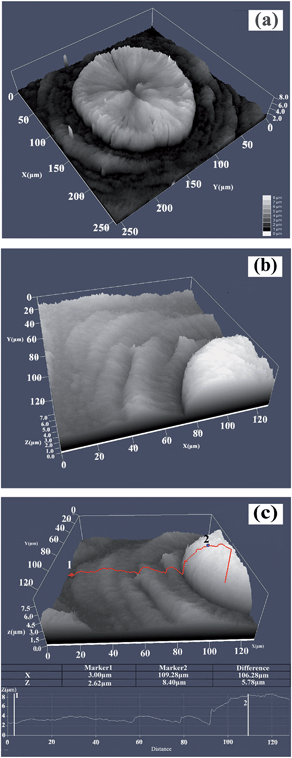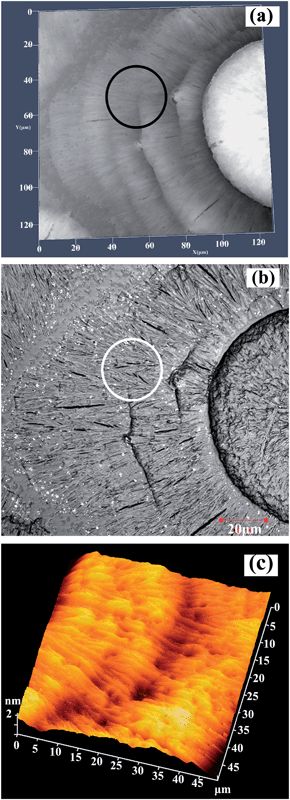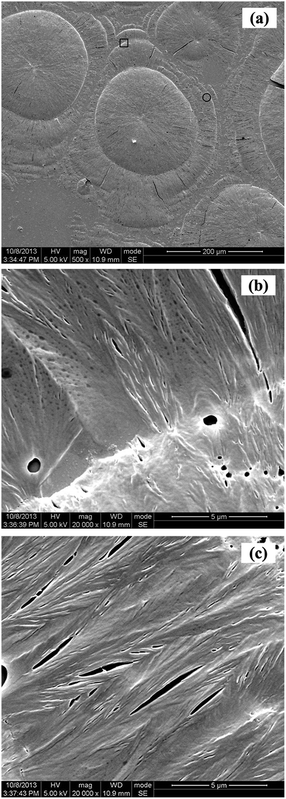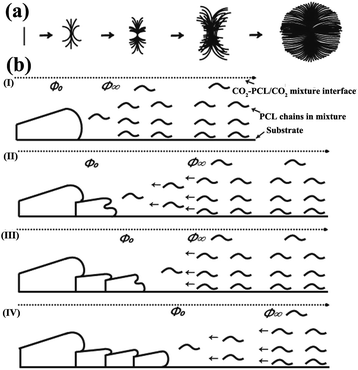Concentric ring-banded spherulites of six-arm star-shaped poly(ε-caprolactone) via subcritical CO2†
Yifan Zhanga,
Xia Liao*a,
Xianglin Luoa,
Suilin Liub,
Qi Yanga and
Guangxian Li*a
aCollege of Polymer Science and Engineering, State Key Laboratory of Polymer Materials Engineering, Sichuan University, Chengdu, Sichuan 610065, China. E-mail: xliao@scu.edu.cn; guangxianli@scu.edu.cn; Tel: +86-28-8540-8361 Tel: +86-28-8546-9011
bAnalytical & Testing Center, Sichuan University, Chengdu, Sichuan 610065, China
First published on 31st January 2014
Abstract
Birefringent Maltese-cross concentric ring-banded spherulites with radial periodic variation of thicknesses grown from six-arm star-shaped poly(ε-caprolactone) (PCL) under the condition of subcritical CO2 were observed in this study. The structure of unique unclassical ring-banded spherulites was found to be different from that of traditional ring-banded spherulites which formed by periodic twisting of lamellar crystals along the spherulite radial direction. Laser scanning confocal microscopy, atomic force microscopy and scanning electronic microscopy images revealed that the ring-banded structure consisted of alternating periodically ridge and valley bands with continuous edge-on lamellae. A two-steps growth mechanism of ring-banded spherulites has been proposed to explain the development of central crystals and periodic ring-bands via CO2.
Introduction
In recent years, CO2 has drawn much attention as a “green solvent” compared with traditional organic solvents used in polymer processing such as polymer blending, microcellular foaming, particle formation, and polymer modification.1 CO2 has substantial solubility in amorphous and semicrystalline polymers, although most polymers cannot dissolve in CO2. The absorbed CO2 in polymer may act as a plasticizer and favor the movement of polymer chains.2 Therefore, the crystallization behavior and crystal morphology of polymer could be modulated under high pressure CO2.Ring-banded spherulites with a typical morphological feature of extinction rings of crystal stacking under polarized optical microscope (POM), which were found in semicrystalline block copolymers, polymer blends,3,4 even in the polymers after annealing,5 have been attracting considerable attention for nearly half a century. However, understand of the mechanism of ring-banded feature of crystal still remains a challenge. Poly(ε-caprolactone) (PCL) with biodegradability and biocompatibility characteristics is a representative polymer forming ring-banded spherulites. In Woo's work,6 ring-bands were observed in neat PCL spherulites at high temperatures. The mechanism of the phenomenon was considered to be the small amount of low-molecular-weight PCL chains acted as self-diluents (plasticizer) interacting with the PCL spherulites to cause interference rings. Yam et al.7 suggested that ring-banded spherulites developed during isothermal crystallization in PCL/poly(vinyl methyl ether) blends were the result of phase separation. Kiran et al.8 didn't observe ring-banded spherulites in PCL under compressed CO2. High crystallinity along with distinct crystal morphology of PCL was obtained at temperatures and pressures where chain mobility was enhanced while the system remained below the crystalline melting temperature. Hua et al.9 investigated the crystal morphologies of PCL and PCL/multi-walled carbon nanotube treated under air and high pressure CO2. It was found that classical ring-banded spherulites grew from solution casting PCL and PCL/multi-walled carbon nanotube films under ambient pressure. After being processed with high pressure CO2, no ring-banded spherulites morphology was observed. The result revealed that PCL melted under high pressure CO2 treatment at the experimental conditions and recrystallized at slow depressurization.
Branched polymers, such as star-shaped polymers, have attracted much attention due to their unique rheological and mechanical properties, and controlled surface function.10 Compared with the linear analogs, star-shaped semi-crystalline polymers illustrate some distinctive morphology and characteristic, such as lower crystallinity, higher equilibrium melting point, and greater tendency to form spherulites.11 However, limited papers investigated the detailed information about crystallization and morphology of star-shaped polymer. In this paper, the effect of CO2 on the crystallization behaviour and crystal morphology of star-shaped PCL has been studied. A unique unclassical concentric ring-banded structure of six-arms star-shaped PCL which consists of alternating ridge and valley bands with continuous edge-on lamellae was found under subcritical CO2 condition. The growth mechanism of ring-banded spherulites induced via CO2 was discussed.
Experimental section
Materials
In this work, PCL was synthesized and characterized as reported earlier.12 The weight-average molecular weight of six-arm star-shaped PCL is 19![[thin space (1/6-em)]](https://www.rsc.org/images/entities/char_2009.gif) 000 g mol−1. The purity of CO2 is 99.9%.
000 g mol−1. The purity of CO2 is 99.9%.
Sample preparation
The sample was dissolved in dichloromethane at room temperature to produce a solution with 1 wt% PCL. 20 μL solution was cast on glass slides, and films with the thickness of about 6 μm on the average were obtained after solvents evaporated completely. To study the effect of compressed CO2 on crystal morphology of PCL, the glass wafers were put into a sealed pressure vessel and exposed to subcritical CO2 under desired pressure. The samples were treated in one bath at 75 °C for 30 min, followed by quickly moving into another bath at 28 °C for isothermal crystallization. The time for isothermal crystallization was 4 h. Subsequently, the pressure in the vessel was slowly depressurized.Characterization
The morphology of spherulites was observed under a BX51 polarized optical microscope (POM) (Olympus; Tokyo, Japan) equipped with a PixeLINK CCD camera. The Laser Scanning Confocal Microscopy (LSCM) experiments were performed using a Zeiss LSM 700 confocal laser scanning microscope (Carl Zeiss; Jena, Germany). The atomic force microscopy (AFM) studies were carried out with a SPA400 atomic force microscope (Seiko Instruments Inc.; Chiba, Japan). The tapping mode uses a 50 μm scanner with a scanning rate of 1 Hz to obtain height and phase images. A scanning electronic microscope (FEI inspect F50) was used to observe the detail structures of ring-bands.Result and discussion
Fig. 1 illustrates the polarized optical micrographs of the crystal morphology of the PCL sample under CO2 at 4 MPa at 28 °C (Fig. 1a) and under air at ambient pressure at 40 °C (Fig. 1b). It is known that compressed CO2 could induce the depression of the glass transition temperature, Tg, and the crystallization temperature, Tc. Zhang et al.13 found out that CO2 delayed the melt crystallization of isotactic polypropylene, and both the crystallization temperature and crystallization rate decreased with increasing CO2 pressure. According to literature, the Tc depression with pressure for PCL is about −2.9 °C MPa−1.14 Therefore, the crystallization temperature at a saturation pressure of 4 MPa decreased 11.6 °C. Hence, PCL sample treated in air at 40 °C was chosen as a contrast with PCL sample treated in 4 MPa CO2 at 28 °C accordingly. As shown from Fig. 1a, the ring-banded spherulites with a pattern of extinction rings can be clearly observed when the sample crystallized under CO2, and the central crystal is much bigger than that in classical ring-banded spherulites.7,15 The distance between crystal centers is 191.12 μm measured by Image-Pro Plus software. While under air at ambient pressure, the typical spherulites with Maltese-cross is detected (Fig. 1b).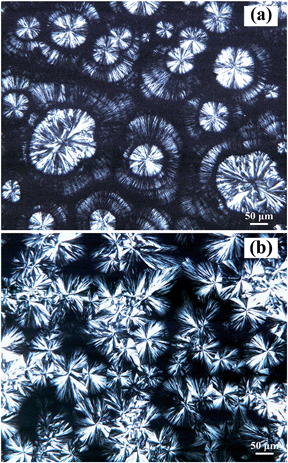 | ||
| Fig. 1 POM images of (a) PCL treated with CO2 at 4 MPa and 28 °C for 4 h, (b) PCL treated in air at 40 °C for 4 h. | ||
The details of the concentric ring-banded spherulites were demonstrated by LSCM as presented in Fig. 2. Fig. 2a shows the whole view of the spherulite. It can be easily discerned that alternating ridge and valleys form the ring-banded spherulite, which correspond to the dark and bright rings in POM micrograph (Fig. 1a). Ring-banded spherulites ridges and valleys which consist of continuous edge-on lamellar crystals could be recognized by the image in Fig. 2b. Furthermore, the height profile in Fig. 2c displays further details. The central crystal is much higher than the bands around. The distance between the highest (mark 2) and the lowest (mark 1) is calculated as approximately 5.8 μm. The band spacing (the distance between the neighboring valleys of the ridge bands) is roughly 13.8 μm–35.5 μm.
The LSCM micrographs in 3D (Fig. 3a) and 2D (Fig. 3b) indicate that the bands around are the result of lamella branched and the ring-bands consist of continuous edge-on lamellae, as evidenced by the circle in the corresponding position of the two images. The AFM image as shown in Fig. 3c illustrates the further microstructure of PCL ring-bands in the location indicated by the black and white circle in Fig. 3a and b, respectively, which reveal that the lamellae grow and branch continuously along the spherulite radial direction with edge-on oriented behavior. The morphology of concentric ring-banded spherulites is analogous to Liesegang rings which have been well-known in small molecule systems and geology subject.16,17 Duan et al.18 and Wang et al.19 found that the unclassical concentric ring-banded spherulites were analogous to Liesegang rings. They thought that the morphology of the concentric ring-banded structure was caused by periodic diffusion-induced rhythmic growth mechanism associated to periodical concentration gradient change. The new lamellar layers developed via a giant screw dislocation mechanism. However, this interpretation cannot explain well the formation mechanism of our concentric ring-banded spherulites, especially valleys and ridges formed by continuous lamellae with edge-on orientation as shown in Fig. 3a and b.
To verify the details of lamellar orientation of PCL ring-banded structure, a distinct morphology of ring-banded spherulites is investigated by scanning electronic microscope (SEM). Fig. 4a illustrates that the lamellae grow along the radial direction at the valley and ridge of the ring bands. The valleys and ridges grow along a certain direction from valley to ridge with continuous edge-on lamellar crystals. The details are amplified in Fig. 4b. Fig. 4c is the image of the valley rings in ring-banded structure, as pointed out in Fig. 4a, which indicates the ring bands consist of continuous edge-on lamellar crystal without changing the direction of PCL lamellar growth. At the valley in Fig. 4c, it clearly shows the lamellar branch and spread out on either side of an invisible crystal axis, which is similar to the growth morphology of poly(vinylidene fluoride).38 Therefore, the change of periodical thinness results in the bright and dark rings.
A widely acceptable interpretation of the extinction bands in classical ring-banded spherulites is that they are caused by the lamellar crystals continuous twisting along the radial growth direction of the spherulites.20,21 While based on experiment results and calculation, Schultz et al.22 ascribed the screw dislocations theory to explain the classical ring-banded spherulites. This theory emphasized that the screw dislocation mainly results in the lamellar crystals discontinuously twisting during the growth. However, the above two theories cannot explain the formation mechanism of ring-banded spherulites perfectly. Keith and Padden23 proposed that the concentric rings might not be only caused by the twisting of lamellar crystals in polyethylene spherulites, but also the consequence of structural discontinuities due to rhythmic crystal growth. Recently, Nonbirefringent concentric ring-banded spherulites consisting of flat-on lamellar with the periodical thinness changing in isotactic polystyrene thin films has been reported by Duan et al.18 These ring spherulites, which were regarded as unclassical ring-banded spherulites comparing with the morphology of classical ring-banded spherulites, were the result of the inability of molten polymer diffusion to keep up with chains depletion at the growth front.
In this work, a two-steps growth mechanism of concentric ring-banded spherulites has been proposed. First of all, during the process of isothermal crystallization, by splaying and branching, dominant lamellae form a skeleton of central crystal in amorphous phase with edge-on lamellae,24 as shown in Fig. 5a. Since the thickness of film is over 500 nm, to decrease surface free energy, lamellae with edge-on orientation is preferred.25,26 At the same time, to feed the central crystals grown forward and upward, polymer chains from neighboring regions are needed, even from relative long distance, according to the research of Wang et al.27 As a result, the growth of the central crystals begins and reaches the highest point. Secondly, at the moment of depressurization, the compressed CO2 dissolved in the polymer phase becomes supersaturated,28 and diffuses away from the crystal growth front,29 which results in the increase of the concentration of PCL chains in PCL–CO2 mixture. The development of the ring-bands is probably due to the CO2 diffusion induced periodic growth associated with the concentration gradient of PCL–CO2 system.
To prove the hypothesis that central crystals formed in the process of isothermal crystallization and the bands around developed during the slow depressurization, the pressure of CO2 was quenched rapidly to atmospheric conditions in 7 s after treated with CO2 at 4 MPa and 28 °C for 4 h. The sample prepared by pressure quenching only shows central crystals (Fig. S1, ESI†), which indicates that the ring-bands possibly grow in the period of slow depressurization. The reason that no ring-bands formed in the sample by rapid depressurization is probably because that the release rate of CO2 is too fast to provide enough time to polymer chains to fold and stack into lamellae. This phenomenon proves the hypothesis that central crystals formed in the process of isothermal crystallization as shown in Fig. 4a and ring-bands grew in the period of slow depressurization. Comparing with the sample treated by slow depressurization, the central crystals of sample prepared by rapid depressurization are found to be imperfect obviously. According to Johnston et al.,30 the interaction of CO2 with polymers contained carbonyl groups might be of a Lewis acid–base nature. Kazarian et al.31 also believed that carbonyl groups may act as an electron donor and exhibit a particular intermolecular interaction with CO2. Consequently, during quick depressurization, a drag force might exist between CO2 and PCL chains. Shieh et al.32 proposed that PCL molecules could be dragged outward by CO2 from the crystallizing PCL lamellar stacks to form either amorphous domains or different size of lamellar stacks during depressurization. Therefore, heterogeneous morphology of the central crystals during fast removal of CO2 was obtained.
To further understand the influence of CO2 on the formation of ring-banded spherulites, PCL samples were treated with CO2 at 28 °C for 4 h at various pressures (Fig. S2, ESI†). No ring-banded spherulites were found in PCL treated at 1 MPa. With an increase in the pressure to 2 MPa, a pattern of indistinct ring-bands were obtained. Further increasing the pressure to 8 MPa, the spherulites with ring-bands of PCL sample was observed. Comparing with the PCL sample treated under CO2 at 4 MPa (Fig. 1a), the distance of the ring-bands of sample treated at 8 MPa decreased. The solubility of CO2 in polymer increases with the increase of CO2 pressure. Therefore, the mobility and concentration gradient of polymer chains increase with pressure. Hence, the feature of ring-bands in PCL appeared and became more obvious and perfect with the increasing of pressure. The results further demonstrated that the formation of ring-banded spherulites is due to the creation of concentration gradient of polymer chains during CO2 depressurization.
The development of ring-banded spherulites with periodic changing of height could be explained through a model of the rhythmic growth process schematized in Fig. 5b. During CO2 isothermal crystallization, the central crystals reach the highest point with the consumption of PCL chains. With a slow release of CO2, the concentration of PCL chains in PCL–CO2 mixture progressively increases. Moreover, slow depressurization provides enough time for PCL chains to rearrange into crystal morphology and avoids the deformation of lamellar stacks caused by drag force. If the rate of lamellae arrangement into ring-bands matches the evacuation speed of CO2 from the mixture system, the concentration of polymer–CO2 system is stable. The concentration φ∞ of PCL chains from the spherulites at large distances is equal to concentration of the polymer–CO2 system. At the growth front, polymer chains consume quickly and replenish from one direction along radius, as the lamellar crystals grow forward. To supplement the depletion of PCL, polymer chains need to move over longer distance. Since the core of the star-shaped PCL located at the fold surface, the incompressibility of this structure could cause the lamellae to diverge.33 Once the diffusion speed of polymer chains from neighboring regions is unable to keep up with the depletion speed of polymer chains at the growth front, the development of lamellar crystal stops and new small lamellae branch from the parents lamellar crystals. The detail of the valleys and ridges formed by continuous lamellae with edge-on orientation and new lamellar grew from parents lamellar branching could be clearly shown in Fig. 3c. This formation process of new small lamella is like that of in polyethylene film which was believed the new (lamellae) sheaves developed by branching from fibrils extending from the upper regions of the old ones.23 The concentration of growth front turns to a lower value φ0 (much smaller than φ∞) which could exactly accommodate the growth of valley but replenish incompetently for the formation of peak. Hence the height of the ridge increases gradually toward the peak but decreases sharply into the valley, as shown in the height profile in Fig. 2c. This process repeats itself periodically and will stop unless the diffusion continues providing to growth front with fewer chains than those required for the continuous growth of ring-bands. During the releasing process, CO2 could affect the concentration of PCL at the growing front of spherulite. Moreover, the supercooling degree of PCL crystallization depresses as the result of exothermic process of CO2 evaporation. However, since the CO2 releases so slowly, the influence of exothermic process of evaporation of CO2 on the ring bands structure is little. Thus, supercooling degree influences little the morphology of ring bands.
It is widely believed that the dissolved CO2 acts as a plasticizer which results in the reduction of the viscosity of polymer and the enhancement of chain mobility.34 Liao et al.35 demonstrated that supercritical CO2 at high pressure and temperature induced the phase transformation of α form crystal to more thermodynamically stable β form crystal of syndiotactic polystyrene by increasing free volume and chains mobility. Shieh et al.36 observed that high-pressure CO2 increased scattering intensity and enhanced the electron density contrast between the crystalline and amorphous layers in poly(ethylene oxide) (PEO)/poly(methyl methacrylate) (PMMA) blends. According to Woods et al.,37 as a solvent, CO2 could induce intermolecular interactions and act as a molecular lubricant which was referred to as plasticization. In this work, since dissolved CO2 augments the PCL chains mobility and decreases the crystallization temperature, central crystals could form at a lower temperature. In the process of slow decompression, the escapement of CO2 increases the concentration of PCL chains, which complements the PCL chains consumed for the growth of crystal. The competition between replenishment and depletion of PCL chains leads to forming alternating ridges and valleys of ring-banded spherulites rhythmically.
Conclusions
In summary, unclassical concentric ring-banded spherulites with alternating periodically ridge and valley bands were obtained in six-arm star-shaped PCL solution-casting films. A two-steps growth mechanism is proposed to explain the formation of ring-banded spherulites via subcritical CO2 treatment. The central crystals formed as the result of the supplement of chains from neighboring regions to complete skeleton of central crystals in CO2 at a lower temperature than that in air due to CO2 plasticization effect. The unique conformation of ring-bands is owing to the incompetent diffusive replenishment rate at the growth front to keep up with the crystal growth velocity and the concentration gradient of PCL–CO2 system. During slow depressurization, CO2 could play as a solvent to give rise to the accretion of PCL chains concentration. The increase in the concentration of PCL chains by CO2 evaporation could partially replenish the consumption of polymer chains due to crystal growth, which leads to the formation of alternating ridges and valleys rhythmically. Since the covalent link of the hyperbranched chains to the rigid core could slow down molecular rearrangement during crystallization and favors ciliation, star polymers show a slower crystallization and a greater tendency to form spherulites than linear polymers. To further understand the growth mechanism of concentric ring-banded spherulites of star-shaped PCL via CO2 and the effect of positional restriction of PCL arms on the crystallization behavior and crystal morphology, the experiments of star-shaped PCL with different arm length and its linear analog treated in subcritical CO2 are ongoing in our laboratory.Acknowledgements
This work is supported by National Natural Science Foundation of China (no. 51103091, 51121001 and 51373103), Scientific Research Foundation for the Returned Overseas Chinese Scholars (no. 20101174-4-3) from the State Education Ministry, and Chengdu City Bureau of Technology, China (no. 11DXYB336JH).Notes and references
- S. P. Nalawade, F. Picchioni and L. P. B. M. Janssen, Prog. Polym. Sci., 2006, 31, 19 CrossRef CAS PubMed.
- Z. Zhang and Y. P. Handa, Macromolecules, 1997, 30, 8505 CrossRef CAS.
- C. He, J. Sun, T. Zhao, Z. Hong, X. Zhuang, X. Chen and X. Jing, Biomacromolecules, 2005, 7, 252 CrossRef PubMed.
- T. Wang, H. Li, F. Wang, J. M. Schultz and S. Yan, Polym. Chem., 2011, 2, 1688 RSC.
- T. Amornsakchai, D. C. Bassett, R. H. Olley, A. P. Unwin and I. M. Ward, Polymer, 2001, 42, 4117 CrossRef CAS.
- E. M. Woo, T. K. Mandal and S. C. Lee, Colloid Polym. Sci., 2000, 278, 1032 CAS.
- W. Y. Yam, J. Ismail, H. W. Kammer, H. Schmidt and C. Kummerlöwe, Polymer, 1999, 40, 5545 CrossRef CAS.
- E. Kiran, K. Liu and K. Ramsdell, Polymer, 2008, 49, 1853 CrossRef CAS PubMed.
- C. Hua, Z. Chen, Q. Xu and L. He, J. Polym. Sci., Part B: Polym. Phys., 2009, 47, 784 CrossRef CAS.
- S. Theiler, M. Teske, H. Keul, K. Sternberg and M. Moller, Polym. Chem., 2010, 1, 1215 RSC.
- E. Núñez, C. Ferrando, E. Malmström, H. Claesson and U. W. Gedde, J. Macromol. Sci., Part B: Phys., 2004, 43, 1143 CrossRef PubMed.
- H. Wen, J. Cao, L. Wang, Y. Chen and X. Luo, Acta Polym. Sin., 2011, 3, 240 CrossRef.
- Z. Zhang, A. V. Nawaby and M. Day, J. Polym. Sci., Part B: Polym. Phys., 2003, 41, 1518 CrossRef CAS.
- J. Reignier, R. Gendron and M. F. Champagne, J. Cell. Plast., 2007, 43, 459 CrossRef CAS PubMed.
- Q. Xiao, S. Yan, K. D. Rogausch, J. Petermann and Y. Huang, J. Appl. Polym. Sci., 2001, 80, 1681 CrossRef CAS.
- H. Krug, H. Brandstädter and K. Jacob, Geol. Rundsch., 1996, 85, 19 CrossRef CAS.
- H. K. Henisch and J. M. García-Ruiz, J. Cryst. Growth, 1986, 75, 195 CrossRef CAS.
- Y. Duan, Y. Zhang, S. Yan and J. M. Schultz, Polymer, 2005, 46, 9015 CrossRef CAS PubMed.
- Y. Wang, C.-M. Chan, L. Li and K.-M. Ng, Langmuir, 2006, 22, 7384 CrossRef CAS PubMed.
- A. Keller, J. Polym. Sci., 1955, 17, 351 CrossRef CAS.
- H. F. Mark, N. Bikales, C. G. Overberger, G. Menges and J. I. Kroschwitz, Encyclopedia of polymer science and engineering, Nonwoven fabrics to photopolymerization, John Wiley and Sons Inc., New York, NY, 2nd edn, 1987, vol. 10 Search PubMed.
- J. M. Schultz and D. R. Kinloch, Polymer, 1969, 10, 271 CrossRef CAS.
- H. D. Keith and F. J. Padden, J. Polym. Sci., 1959, 39, 123 CrossRef CAS.
- M. Tsuji, M. Fujita, T. Shimizu and S. Kohjiya, Macromolecules, 2001, 34, 4827 CrossRef CAS.
- H. Schönherr and C. W. Frank, Macromolecules, 2003, 36, 1188 CrossRef.
- C.-M. Chan and L. Li, Adv. Polym. Sci., 2005, 188, 1 CrossRef CAS.
- Z. Wang, G. C. Alfonso, Z. Hu, J. Zhang and T. He, Macromolecules, 2008, 41, 7584 CrossRef CAS.
- K. Taki, D. Kitano and M. Ohshima, Ind. Eng. Chem. Res., 2011, 50, 3247 CrossRef CAS.
- T. Oda and H. Saito, J. Polym. Sci., Part B: Polym. Phys., 2004, 42, 1565 CrossRef CAS.
- S. Mawson, K. P. Johnston, J. R. Combes and J. M. DeSimone, Macromolecules, 1995, 28, 3182 CrossRef CAS.
- S. G. Kazarian, M. F. Vincent, F. V. Bright, C. L. Liotta and C. A. Eckert, J. Am. Chem. Soc., 1996, 118, 1729 CrossRef CAS.
- Y.-T. Shieh and H.-S. Yang, J. Supercrit. Fluids, 2005, 33, 183 CrossRef CAS PubMed.
- E. Núñez and U. W. Gedde, Polymer, 2005, 46, 5992 CrossRef PubMed.
- G. Teramoto, T. Oda, H. Saito, H. Sano and Y. Fujita, J. Polym. Sci., Part B: Polym. Phys., 2004, 42, 2738 CrossRef CAS.
- X. Liao, J. He and J. Yu, Polymer, 2005, 46, 5789 CrossRef CAS PubMed.
- Y.-T. Shieh, K.-H. Liu and T.-L. Lin, J. Supercrit. Fluids, 2004, 28, 101 CrossRef CAS.
- H. M. Woods, M. M. C. G. Silva, C. Nouvel, K. M. Shakesheff and S. M. Howdle, J. Mater. Chem., 2004, 14, 1663 RSC.
- H. Kajioka, A. Hoshino, H. Miyaji, Y. Miyamoto, A. Toda and M. Hikosaka, Polymer, 2005, 46, 8717 CrossRef CAS PubMed.
Footnote |
| † Electronic supplementary information (ESI) available: The POM image of PCL treated with CO2 at 4 MPa and 28 °C for 4 h and subsequently quenched to ambient pressure in 7 s; the POM image of PCL crystalize at 28 °C for 4 h at various pressures under CO2. See DOI: 10.1039/c3ra47503d |
| This journal is © The Royal Society of Chemistry 2014 |

